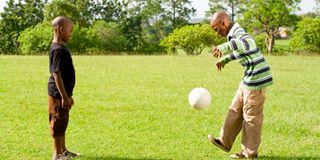Everything you need to know about raising an epileptic child

The impact of epilepsy varies from one child to another.
What you need to know:
- A ketogenic diet could be recommended for your child.
- Despite your child being epileptic, he still has the same capabilities and same level of intelligence as other children.
- Acknowledge that the child will soon become a teenager and later an adult, and start nurturing independence in them.
When Marion began to have speech arrests, people mistook her inability to utter words for rudeness. Her mother, Sheila Mumbi says that she would talk to the seven-year-old girl and she would just stare back without answering. “Sometimes she silently stared at things. I did not know what was wrong with her but didn’t think it was serious,” says Sheila. Marion’s teacher also noticed that she was drooling and pouring saliva on herself. “This made me anxious and more observant. I noticed that she had speech arrests soon or immediately after waking up,” says Sheila a mother of three. Her pediatrician put her through a series of tests and was diagnosed with Benign Rolandic Epilepsy, one of the various types of epilepsy that affect children.
According to pediatrician Benson Karanja, epilepsy, a condition that causes the victim to have recurring seizures, is as common in children as it is in aging people. In children, though, epilepsy is not easy to diagnose at home. Most parents will confuse it with related events such as febrile convulsions. “Febrile convulsions are fits that can occur when a child has fever between the age of 6 months and 3 years,” says Dr. Karanja. Apart from these convulsions, fainting spells, daydreaming, nightmares, gastrointestinal and heart problems, psychological problems, migraines, and normal sleep jerks are some childhood events that are often confused with epileptic seizures.
What is it and what causes it?
According to the World Health Organization, epilepsy is the most common form of chronic brain disease. Epilepsy affects people of all ages, with more than 50 million people globally estimated to have it. The WHO also estimates that up to 70 percent of people with epilepsy could live without experiencing seizures if they are diagnosed properly and treated promptly. “Epilepsy is mainly characterised by recurrent seizures involving episodes of involuntary body movement. These movements may involve the whole body or they could be partial body movements,” says the WHO.
These body movements are sometimes accompanied by loss of consciousness and loss of control of bowel and bladder function.
Seizures in epileptic people are caused by excessive electrical discharge of a group of cells in the brain. The WHO says that seizures in patients will vary from several per day to one per year. In children, Dr. Karana says that epilepsy is mainly caused by a variety of health and developmental deficiencies such as their genetic makeup, head injury, infections of the brain and its coverings, lack of oxygen, and disorders in brain development. Hydrocephalus is one of the brain disorders that can result in epilepsy. With this condition, the brain’s cavities tend to accumulate fluid which leads to seizures.
Types of epilepsy
Lennox-Gautant syndrome: It’s common in children between the ages of one to eight years and usually includes mixed types of seizures like drop attacks and convulsions. Children encounter delays in their development.
Infantile spasms: It’s one of the most serious types and is often accompanied by other forms of seizures that delay a child’s development. Children are prone to self-injury and accidents as they are likely to accidentally fall forwards.
Temporal lobe: It can strike a child at any age and involves complicated but partial seizures. Children look confused and drool a lot. Treatment for it may have to be surgical.
Childhood absence epilepsy: It hits between ages four to ten and includes brief spells of seizure. It is usually outgrown.
Diagnosis
The type of epilepsy that a child has is diagnosed with the help of a medical program that is known as an electroencephalogram (EEG). Your child may however be recommended for an MRI (Magnetic Imaging Resonance) scan if the doctor suspects that he or she has a brain lesion. According to Dr. Karanja, other than the scan, a child can be diagnosed with epilepsy if he or she has recorded multiple seizures without any known causes. “The diagnosis procedure will involve a physical examination to assess the child’s cardiac, mental, and neurological state, a computerised axial tomography or CT scan to determine if the seizures are being caused by a neurological lesion or illness, and a blood test to identify whether the child has other secondary conditions such as diabetes,” says Dr. Karanja.
Treatment
The impact of epilepsy varies from one child to another. “There should be a differentiation between generalised and partial seizures in determining the proper treatment,” says Dr. Karanja.
In any given event, epilepsy in children is managed through medication. Numerous forms of seizures are usually outgrown. But apart from medications, a ketogenic diet could be recommended for your child. This is a diet that is low in carbohydrates and high in fat. This diet, also known as the keto diet, has been medically proven to have benefits against diabetes, epilepsy, cancer, and Alzheimer's disease. “When put on this diet, your child will make ketones, which are chemicals that are made from the breakdown of body fat. These chemicals are usually used as a source of energy by the brain and the heart,” says Dr. Karanja.
According to child therapist Gloria Wandeto, it is important to remember that despite your child being epileptic, he has the same capabilities and same level of intelligence as other children. Do not hold back from teaching him or her how to be independent. “Don’t be overprotective. Acknowledge that the child will soon become a teenager and later an adult, and start nurturing independence in them,” she says.
Things that may trigger an epilepsy seizure
- Lack of enough sleep
- Stress and excitement
- Menstruation
- Missed meal
- Missed medication
- Drinking alcohol
- Taking illicit drugs
- Flickering lights or patterns
- Illness (especially diarrhea or vomiting)
- High body temperature
Causes of epilepsy
- Brain damage or injury
- Brain tumor
- Infections like cerebral malaria, meningitis, HIV/AIDS, and tuberculosis.
- Stroke
- Birth complications
- Alcohol or drugs
- Inheritance/Genetics
Conditions that may be mistaken for epilepsy
- Fainting
- Breath-holding spells
- Hysteria
- Daydreaming
- Sleepwalking
- Tics
- Tourette’s syndrome
- Febrile convulsions
Drugs and hospital consultation
- The consultation and the drugs in public hospitals in Kenya cost about Sh. 500 per month (Sh. 200 for consultation and Sh. 300 for the drugs). However, treatment costs may vary from patient to patient, and from hospital to hospital.
- Anti-Epilepsy Drugs (AED) are commonly administered to patients.





